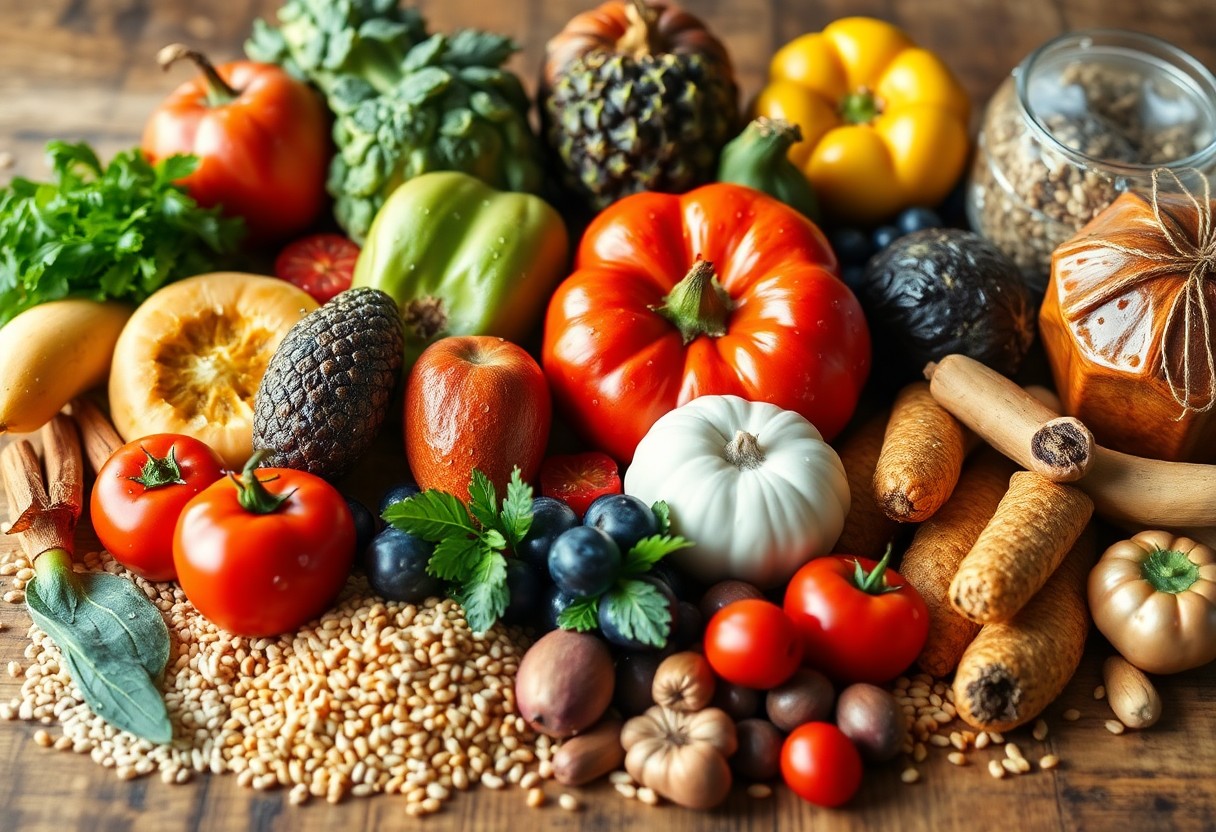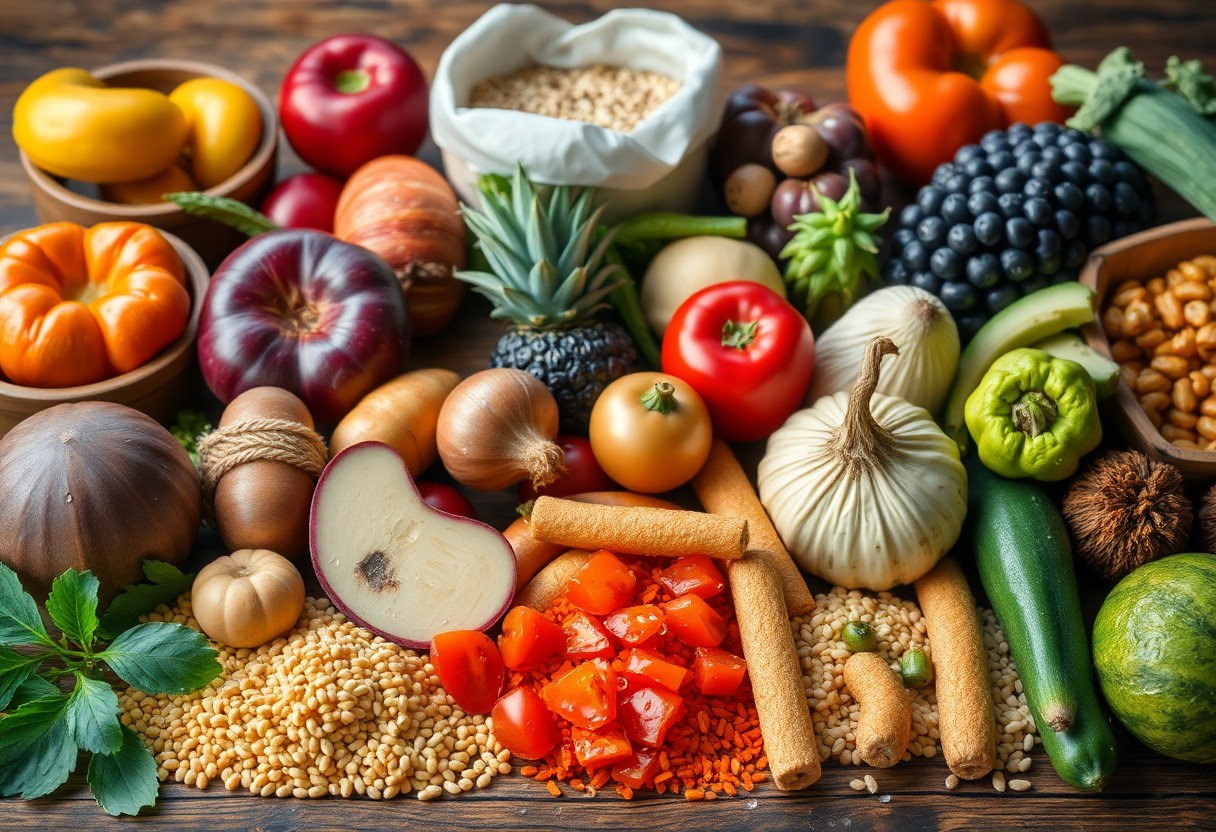With a daily requirement of water for optimal health, you might be surprised to learn that your food contributes significantly to your hydration. On average, 20% to 30% of your total water intake comes from solid foods, with fruits and vegetables being the most hydrating options. For instance, foods like cucumbers and watermelons are comprised of over 90% water. Understanding how much water you’re consuming through your diet can help you maintain proper hydration levels, ultimately supporting your overall well-being.
Key Takeaways:
- Food contributes significantly to daily water intake, with certain fruits and vegetables containing up to 90% water.
- On average, around 20-30% of total daily hydration can come from food sources, particularly those with high moisture content.
- Considering water-rich foods in your diet can help maintain hydration levels, especially in conjunction with drinking water.
The Water Content of Common Foods
The hydration potential of your meals is greater than you may think, with various foods acting as natural water sources. Different categories, particularly fruits and vegetables, play significant roles in contributing to your daily fluid intake. By knowing the water content of these foods, you can better tailor your diet to ensure you stay hydrated while enjoying diverse flavors and textures.
Fruits: Nature’s Juicy Hydrators
Fruits are often celebrated for their high water content, making them excellent choices for hydration. Watermelon, for instance, contains around 92% water, while strawberries and cantaloupe also boast impressive figures, ranging from 90% to 91%. Incorporating a variety of fruits into your diet not only helps meet hydration needs but also provides imperative vitamins and antioxidants.
Vegetables: The Unsung Heroes of Hydration
Vegetables can be incredibly hydrating, with many types containing significant amounts of water. Cucumbers, lettuce, and celery are among those that can comprise over 95% water, serving your hydration requirements while adding fiber and nutrients to your meals. Their water-rich nature makes them an ideal choice for salads, soups, and snacks.
When you think about vegetables, options such as zucchini and bell peppers come to mind, both containing over 90% water. Including a variety of these fresh, low-calorie options in your meals can enhance your fluid intake while providing imperative minerals like potassium and magnesium that support hydration on a cellular level. Think of vegetable-based dishes as not only meals but also a way to quench your thirst.
Grains and Protein Sources: Assessing Their Moisture Levels
While grains and protein sources aren’t primarily known for hydrating effects, they can still contribute beneficial moisture levels. Cooked grains like quinoa and rice contain around 70-80% water, and legumes such as beans provide moisture while adding fiber and protein to your diet. Although these foods are less water-dense, they play a role in overall hydration when prepared correctly.
Adopting cooking methods that incorporate more water can enhance the moisture content of grains and proteins. For example, soaking beans before cooking and using broth for cooking grains can boost their hydration potential. Combining these foods with water-rich fruits and vegetables creates a well-rounded and hydrating meal that promotes your daily water intake without relying solely on beverages.
Calorie-Dense Foods and Their Water Contribution
Calorie-dense foods, such as nuts, oils, and processed snacks, often offer minimal water content compared to their caloric value. For instance, while a typical avocado contains around 75% water, a serving of peanut butter consists of less than 10% water. As you consider your dietary choices, incorporating foods that strike a balance between calories and hydration can improve your overall water intake, ensuring you stay well-hydrated without excessive calorie consumption.
The Role of Cooking: How Preparation Alters Water Content
Cooking can significantly affect the water content of foods. Methods such as boiling or steaming can lead to leaching of nutrients and water, while roasting may cause foods to lose moisture. For example, boiling vegetables can reduce their water content by up to 50%, whereas roasting might concentrate their flavors and reduce the overall water percentage. Paying attention to preparation techniques allows you to maximize both flavor and hydration in your meals.
Exploring Processed Foods: More or Less Hydration?
Processed foods typically provide a varied level of hydration, often dependent on their formulation. Many snacks, like potato chips, lack moisture entirely, while others, such as canned soups or fruit juices, can offer substantial hydration. It’s important to differentiate between nutrient-rich processed options versus those laden with empty calories, as the latter often lead to dehydration instead of nourishment.
Delving deeper into the hydration levels of processed foods reveals a mixed picture. For instance, while canned vegetables retain some water, energy-dense snacks like granola bars or cookies tend to be dehydrated forms, offering little in the way of hydration. Additionally, sugary beverages may contribute water but lack important nutrients, thereby making them less beneficial overall. Balancing your intake by choosing minimally processed options can enhance hydration without compromising nutrition.

The Impact of Food Choices on Daily Hydration
Your daily hydration levels are significantly influenced by the food you consume. Foods with higher water content can contribute to your overall fluid intake, while calorie-dense items might leave you thirstier. Vegetables and fruits generally provide a refreshing source of hydration, placing emphasis on how your dietary choices can either support or hinder your body’s hydration status. By considering the water content of your meals alongside your fluid intake, you can better manage your hydration needs throughout the day.
Balancing Solid and Liquid Intake for Optimal Hydration
Hydration Awareness: Interpreting Nutrition Labels
Cultural and Regional Variations in Food Hydration
Food hydration varies widely across different cultures and regions, reflecting climate, agricultural practices, and dietary traditions. In arid regions, you might find a greater reliance on moisture-rich foods like melons and cucumbers, while in humid climates, dense grains and legumes play a significant role in hydration. Additionally, cultural preferences influence which foods are prioritized, shaping local diets that are as much about hydration as they are about flavor and nutrition.
Traditional Diets Around the World: A Global Perspective
Examining traditional diets reveals striking differences in water content among staple foods. For instance, the Mediterranean diet emphasizes fruits and vegetables, which can be high in water content, while traditional diets in Northern regions may focus more on grains and meats with lower moisture levels. These dietary patterns have evolved to suit local environments and climatic conditions, providing not only nourishment but also hydration from the foods your ancestors cultivated.
Seasonal Foods and Their Water Content: Aligning with Nature
Seasonal foods inherently align with your body’s hydration needs, as many water-rich fruits and vegetables peak during warmer months. By consuming seasonal produce, you benefit from the natural availability of moisture-dense options like berries, tomatoes, and peppers in summer, and hearty root vegetables in winter that, while lower in water, still contribute to overall hydration.
Choosing seasonal foods can enhance your hydration strategy significantly. During summer, juicy fruits such as watermelon and peaches—often exceeding 90% water—become staples, replenishing lost fluids from heat and outdoor activities. Conversely, winter’s harvest highlights squash and cabbage, which may contain less water but are still beneficial for hydration due to their fiber content and ability to retain moisture during cooking. By aligning your diet with the seasons, you ensure a more hydrating and nutritionally balanced intake throughout the year.

Myths and Misunderstandings About Food and Hydration
Misunderstandings about the relationship between food and hydration can lead to inadequate fluid intake and poor health. Many people often overlook the substantial water content found in various foods, assuming that beverages alone suffice for hydration. This section tackles common myths and clarifies how food plays a pivotal role in your hydration needs.
Debunking the “Drinking Water is Enough” Notion
Many individuals cling to the notion that simply drinking water meets all hydration requirements. However, relying solely on fluid consumption can be misleading. While water is vital, numerous foods also contribute significantly to your daily hydration, ranging from fruits and vegetables to soups and broths. Ignoring the water found in food can prevent you from achieving optimal hydration levels.
Clarifying Misconceptions: How Food Contributions Matter
Understanding food’s role in hydration can shift your approach to wellness. For instance, about 20% of your daily water intake can come from food sources, with high-water-content fruits like watermelon and cucumbers leading the pack. Including these foods in your diet not only assists in hydration but also provides vital vitamins and minerals that beverages alone cannot offer.
Consider integrating hydration-friendly options into meals. For example, incorporating leafy greens, fruits like oranges, and soups can effectively boost your water intake. Watermelon, with about 92% water, and cucumbers at 95%, exemplify how tasty and hydrating foods can simultaneously satisfy hunger and enhance fluid balance. By adjusting your diet to include these foods, you can improve your overall hydration, making fluid management more efficient without solely relying on beverages.
Conclusion
Taking this into account, understanding how much water you typically get from food can greatly enhance your hydration efforts. Foods such as fruits and vegetables can provide a significant portion of your daily water intake, complementing the fluids you drink. By being aware of your food choices and their water content, you can better manage your hydration and overall well-being, ensuring that you maintain optimal health through a balanced diet.
FAQ
Q: How much water can be obtained from fruits and vegetables?
A: Fruits and vegetables are significant sources of moisture in a diet. For example, cucumbers and lettuce contain about 95% water, while watermelon has around 92%. On average, fruits and vegetables can provide about 20-30% of daily water intake, depending on how much is consumed.
Q: What are some hydrating foods aside from fruits and vegetables?
A: Aside from fruits and vegetables, other hydrating options include soups, stews, and smoothies. Certain dairy products, like yogurt, also have high water content. Even cooked grains and legumes can contribute to hydration as they absorb water during preparation.
Q: Does the water content in food vary significantly?
A: Yes, the water content in foods can vary greatly. For example, dry foods like nuts and dried fruits contain very little water, while foods like cucumbers and strawberries are mostly water. Understanding these differences can help in planning a hydration strategy that incorporates both food and drink.
Q: How can I track my hydration from food and drink?
A: You can track hydration by maintaining a food diary that includes water content of the foods you consume. Many food databases provide information on moisture content. Additionally, keeping a record of your water intake from beverages can help you see how much overall hydration you’re getting.
Q: Is it enough to rely solely on food for hydration?
A: While foods contribute to overall water intake, it’s generally advisable to consume fluids as well. Beverages like water, herbal teas, and other low-calorie drinks can help meet hydration needs more consistently. The balance between food and drinks will often depend on individual activity levels and environmental factors.
